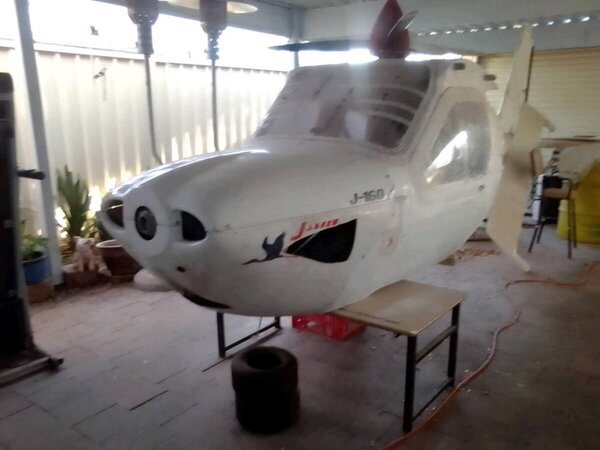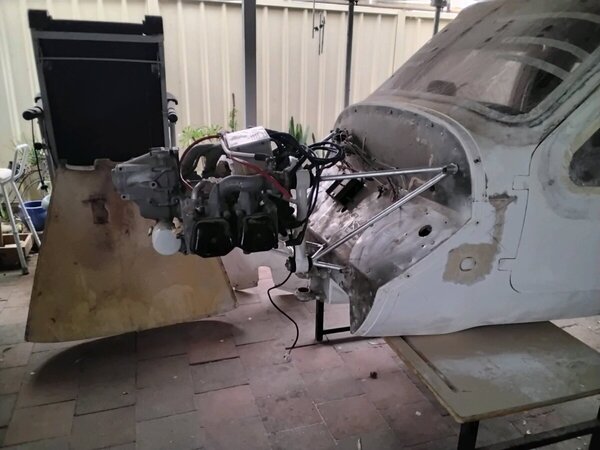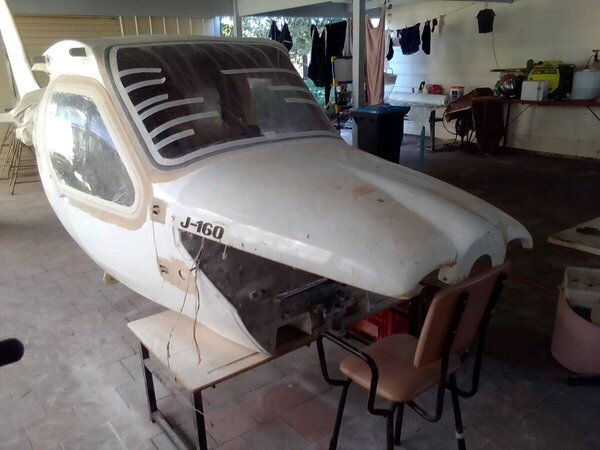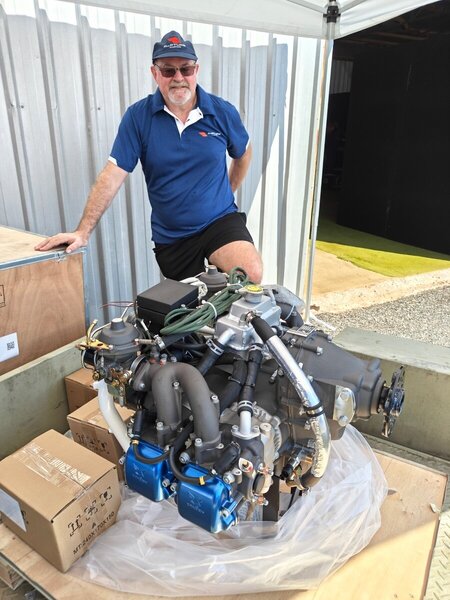-
Posts
54 -
Joined
-
Last visited
-
Days Won
8
Information
-
Aircraft
Rapture Bug
-
Location
Adelaide
-
Country
Australia
Recent Profile Visitors
The recent visitors block is disabled and is not being shown to other users.
Rapture's Achievements

Well-known member (3/3)
-

Zonsen Aero Engines - Rapture Aviation (Adelaide)
Rapture replied to Rapture's topic in AUS/NZ General Discussion
We are trying hard to keep the modifications to the J160 airframe minimal so that future conversions are both minimum cost and complexity. The above photo shows that the stock cowling still fits fine. With our 110hp CA510 being fully liquid cooled, we might even be able to plug some of the holes in the stock cowling to reduce some drag. -

Zonsen Aero Engines - Rapture Aviation (Adelaide)
Rapture replied to Rapture's topic in AUS/NZ General Discussion
It’s a very old, junker 912 but is dimensionally correct for the Zonsen installation so is good for the mock up. -

Zonsen Aero Engines - Rapture Aviation (Adelaide)
Rapture replied to Rapture's topic in AUS/NZ General Discussion
While we will shortly be delivering our brand new 110hp Zonsen CA510 engine to the aircraft, an old Rotax is being used to finalise the engine mount geometry, as well as to facilitate the installation of the final engine accessories such as radiator, oil tank and cooler etc. When the new Zonsen engine arrives at the airframes location, we will be able to drop it straight in to replace the Rotax. The attached photo shows the Rotax and the associated firewall to engine ring frame mount. A jig will be fabricated from this first (non-airworthy) engine mount from which the airworthy mount will be made. The prop hub has been determined to be in the identical position to the Jabiru hub and we hope to be able to use the original cowling with minimal modifications. Now to plan the installation of the engine accessories.- 168 replies
-
- 10
-

-

-
Rapture started following Looking for Seabird Rouseabout
-

Looking for Seabird Rouseabout
Rapture replied to FlyingVizsla's topic in Aircraft General Discussion
I flew one of these aircraft for about 20 minutes as part of a demonstration day when Seabird was looking for funding. The potential investors asked me to fly it and report to them about its performance. I recall that it was very sensitive in pitch but if flown with two fingers with very gentle inputs, it behaved as advertised. I can still vividly recall telling the very experienced cropduster pilot who flew it after me about the pitch sensitivity, to then watch him jump in, start it up apply full power and after takeoff experienced major pios. There was one power setting where the König 3 cylinder set up a very prominent buzz through the airframe which worried me a bit at the time. That said, it was a fun to fly aircraft and I’m pleased Seabird managed to move ahead. -

Zonsen Aero Engines - Rapture Aviation (Adelaide)
Rapture replied to Rapture's topic in AUS/NZ General Discussion
And getting back onto topic, progress has been made on the J160 Zonsen conversion. The restoration of the J160 moves ahead with the new glass having now been installed. The airframe itself is now pretty well done with a new factory interior to be installed. Here she is with the new glass installed. -

Zonsen Aero Engines - Rapture Aviation (Adelaide)
Rapture replied to Rapture's topic in AUS/NZ General Discussion
The 110hp CA510 has no Rotax equivalent. It is fully water cooled, and does not require any air cooling of the heads etc. This explains the different architecture of this model. -

Zonsen Aero Engines - Rapture Aviation (Adelaide)
Rapture replied to Rapture's topic in AUS/NZ General Discussion
For those that didn't make it to AusFly, here is a photo of our 110hp CA510 minutes after we opened the crate which had only arrived in Adelaide a few days before the event and we were that busy that we didn't open the crate until we had arrived at Wentworth. Luckily, it was all there and in excellent condition. The fine specimen of a man watching over it is Milton, owner of the yellow Lightning Bug who by the way is selling that Bug to help fund getting the next Bug flying with a Zonsen engine in it. The boxes that came with the engine contained the accessories that we ordered with it such as mounting rubbers, etc. -

Zonsen Aero Engines - Rapture Aviation (Adelaide)
Rapture replied to Rapture's topic in AUS/NZ General Discussion
It is not certified but it is ASTM compliant and comes with the statement from Zonsen if requested. Under the MARAP framework, we will complete the installation and seek approval under the MARAP framework to maintain it as a S-LSA, allowing continued use in commercial operations, i.e for flying school duties. If other Jab owners want to do the same thing, approvals are on a one-off basis so each installation must go through the same approval process. -

Zonsen Aero Engines - Rapture Aviation (Adelaide)
Rapture replied to Rapture's topic in AUS/NZ General Discussion
Having now spoken with several J160/J230 owners who have retrofitted Rotax engines to their airframes, and also having spoken with several of the individuals/teams that actually undertook the conversions, It is very interesting to note their experiences and also their aircraft’s demonstrated performance with the Rotax installed. I am not going to repeat them here as the information would be second hand, but it is motivating for us to fit and demonstrate some Zonsen engines in Jabiru airframes. To that end, we now have a J160 airframe being prepared to have the 110hp Zonsen CA510 that we took to AusFly installed. Once that combination is flying, we will be able to provide first hand performance figures for the combination. We also intend to take that aircraft on a demonstration tour to allow flying schools and Jab owners to experience the conversion for themselves. This will also build hours on the engine in real life operation that together in conjunction with other Zonsen dealers around the world, we can start building reliable data about the reliability of the engines. It’s a start…. Anyway, here’s a photo of the recipient J160 that is currently undergoing a full restoration with the necessary firewall forward and instrument panel conversion to be undertaken. Standby for further updates.- 168 replies
-
- 10
-

-

-

Zonsen Aero Engines - Rapture Aviation (Adelaide)
Rapture replied to Rapture's topic in AUS/NZ General Discussion
Thanks Burnie. You have hit the nail on the head with that statement. Zonsen have indicated to me that they consider the Australian market to be an important one. But as you say, consumers in Australia like to see OEM support for their products in Australia and there are certainly ways that such support can be demonstrated. -

Zonsen Aero Engines - Rapture Aviation (Adelaide)
Rapture replied to Rapture's topic in AUS/NZ General Discussion
Burnie, it is not possible to give you what you want because the engine is new enough and not prolific enough to be able to furnish you with the data that you want. You are essentially seeking third party validation of quality and reliability. That data is not yet available and that has been stated already several times on this thread so continuing to ask for it is not going to change the fact that the information that you seek is not yet available. Please ask again in 2 years and we should have the independent validation that you seek. We are aware that sales will likely be slow until such validation is available. I think we probably all agree that an initiative by the manufacturer to incentivize some customers to take the engines, build time on them quickly and get the third party validation of quality, safety, reliability and customer support so that potential customers need not fear that element of the buy decision. -

Zonsen Aero Engines - Rapture Aviation (Adelaide)
Rapture replied to Rapture's topic in AUS/NZ General Discussion
Zonsen have exceptional engine test facilities at their manufacturing and assembly plant in Chongqing. The majority of their engines have gone through the accelerated testing process required to obtain ASTM approval. So they’ve already essentially done your test. -

Zonsen Aero Engines - Rapture Aviation (Adelaide)
Rapture replied to Rapture's topic in AUS/NZ General Discussion
Okay readers, please take a deep breath and stop bashing Zonsen simply because they are a Chinese company and PLEASE can we stay on topic about Zonsen specifically and the Zonsen products. Their factory is amazing! Immaculately clean, extremely ordered, fully automated (robots collect parts off the shelves and deliver to the assembly stations), technicians are uniformed and white coated and skilled, the quality assurance section is extremely well equipped with the technicians being skilled at what they do. On that topic, our first engine was delayed after the Zonsen QA process identified an issue with parts of our engine which were subsequently remanufactured. The QA system worked and the Zonsen desire to only send out engines that meet their stringent quality requirements was met. Their manuals were pleasantly fairly good, with some English language errors evident but feedback that I have given has been immediately addressed and they’ve sent me a new updated manual within days of me providing my feedback. With more feedback, their manuals will improve, but their first cut at them has been pretty good. We all get that hours need to be put on the engines and third party validation of the product is required in order to build a reputation. I’d love to drop 10 engines into the market here and have them fly their backsides off so that we can then point to a demonstrated history of reliability and associated product support. I reckon that is what we need, but as the distributor, I cannot wear that cost or risk. That said, there have been many sales into Europe so we should start getting more data on the success of the engines there, along with reports of first hand experience by unrelated parties. So please, back on topic and let’s stop with the generic China product bashing. Don’t tar Zonsen with that brush until there is evidence to support the tarring… or there is evidence to support a good reputation. -

Zonsen Aero Engines - Rapture Aviation (Adelaide)
Rapture replied to Rapture's topic in AUS/NZ General Discussion
Believe me, I hear you. The aero division of Zonsen have been very good to deal with, but I think they are still coming to grips with Western mentality and mindset. Building a reputation needs to come from the manufacturer and there are clear metrics around what elements of a business and their product will positively enhance a reputation, particularly in the aviation sector. A demonstrated history of a reliable, safe and well supported product is critical, not just on a sample of one, but on a sample of many and over a sustained period. Distributors have the ability to support the initiatives of the manufacturers to raise the level of credibility and trust in a product, but ultimately, responsibility rests with the manufacturer to enhance their own profile. -

Zonsen Aero Engines - Rapture Aviation (Adelaide)
Rapture replied to Rapture's topic in AUS/NZ General Discussion
We raised this issue with Zonsen, particularly as it relates to trying to break into a market with a new and unproven engine, combined with a new manufacturer who has yet to establish a good reputation for product quality and product support. Unfortunately, the cost is what it is. What the manufacturer needs to do is to build the reputation and the brand so that the products and product support are at least equal to or preferably exceed that of Rotax, then the $4000 price differential will be a point of difference in their favour.








